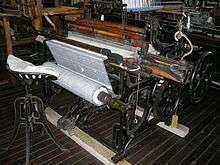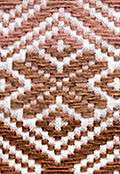Hattersley loom
The Hattersley loom was developed by George Hattersley and Sons of Keighley, West Yorkshire, England. The company had been started by Richard Hattersley after 1784, with his son, George Hattersley, later entering the business alongside him. The company developed a number of innovative looms, of which the Hattersley Standard Loom – developed in 1921 – was a great success.
Hattersley Standard Loom
Hattersley Standard Loom In 1921 the Hattersley Standard Loom, designed and built by the company, was to sell in its thousands, bringing considerable financial success to the company.[1] After the recapitalisation boom of 1919 cotton yarn production peaked in 1926, a further investment was sparse. Rayon, artificial silk, was invented in the 1930s in Silsden nearby, and the Hattersley Silk Loom was adapted to weave this new fabric.
- rear view
- left drop box
- different drop box control chains
- right drop box
- left drop box with shuttle
- another rear view
- shaft dobby mechanism
- front view with reed
Hattersley Domestic Loom

The plain Hattersley Domestic Loom was specially developed for cottage or home use and designed to replace the wooden handloom; the Domestic is similar in construction to a power loom. It was introduced ca.1900 and the makers claimed that a speed of 160 picks per minute could be easily attained with from 2 to 8 shafts weaving a variety of fabrics. Because foot pedals, or treadles, operate the loom it is still classed as a handloom, but it is much easier and faster to weave as all the motions of the loom are connected via crankshaft and gear wheels. The cast metal chair, manufactured along with the loom, can be raised or lowered to suit, and the seat rocks forward and back as the weaver treadles the loom.[1] There is an example in the Bradford Industrial Museum.
Jacquard Tapestry Loom


Artworks could be replicated on mass by use of the Hattersley Jacquard (Tapestry) Loom. For example, Sir Edwin Henry Landseer's painting Bolton Abbey in Ye Olden Times was produced in tapestry form by a Jacquard Loom at a Franco-British exhibition in 1908.[2] There is a Hattersley Jacquard (tapestry) loom located at Queen Street Mill in Burnley.[2]
References
- ↑ Interpretative panel at Bradford Industrial Museum
- 1 2 "Queen Street Mill Textile Museum". Lancashire Museums. Retrieved 4 May 2013.
